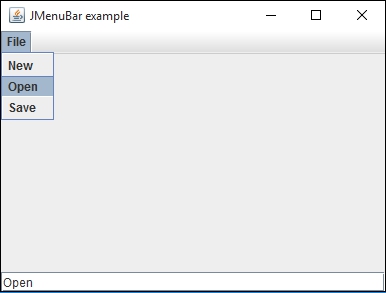大多数基于 GUI 的应用程序在顶部都有一个菜单栏。它位于顶级窗口的标题栏正下方。javax.swing 包具有构建高效菜单系统的精心设计工具。它是在 JMenuBar、JMenu 和 JMenuItem 类的帮助下构建的。
在以下示例中,顶级窗口中提供了一个菜单栏。由三个菜单项按钮组成的 File 菜单将添加到菜单栏中。现在,让我们准备一个 JFrame 对象,并将布局设置为 BorderLayout。
现在,JMenuBar 对象由 SetJMenuBar() 方法激活。
接下来,声明具有 'File' 标题的 JMenu 对象。三个 JMenuItem 按钮被添加到 File 菜单中。单击任何菜单项时,将执行 ActionEvent 处理程序 OnClick() 函数。它是使用 actionPerformed 属性定义的。
OnClick() 事件处理程序通过 gwtActionCommand() 函数检索 JMenuItem 按钮的名称,并将其显示在窗口底部的文本框中。
File (文件) 菜单对象被添加到菜单栏中。最后,在 JFrame 对象的底部添加一个 JTextField 控件。
menu.py 的整个代码如下 -
使用 Jython 解释器执行上述脚本时,将出现一个带有 File 菜单的窗口。单击它,它的三个菜单项将下拉。如果单击任何按钮,其名称将显示在文本框控件中。




